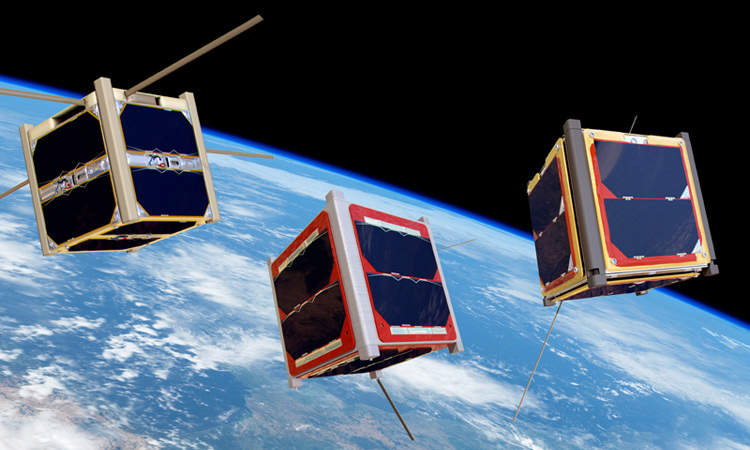 CubeSats with Earth in the background. [NASA]
CubeSats with Earth in the background. [NASA]
The next rocket launch to ferry cargo to the International Space Station (ISS), or to carry a major spacecraft to low Earth orbit, may also bring along some tiny hitchhikers. At the appointed moment, the launch vehicle will eject several small metal boxes—ranging in size from a grapefruit to a shoebox—that will scoot away to start their own missions.
Increasingly, these miniaturized spacecraft, known as CubeSats, are conveying scientific instruments, technological proofs of concept and educational challenges into outer space. Many CubeSat payloads involve optics: spectrometers, visible-light and infrared cameras, free-space optical communications hardware and, of course, photovoltaic panels for power.
Increasingly, these miniaturized spacecraft are conveying scientific instruments, technological proofs of concept and educational challenges into outer space.
Born from a couple of engineering professors’ desire to empower their graduate students to build basic satellites, then enabled by the ongoing shrinkage of electronic and optical components, CubeSats have taken off beyond the university and laboratory settings. Dozens of companies already sell off-the-shelf CubeSat components, provide engineering and consulting help to satellite builders or offer launch services. At least two firms are providing customers with remote-sensing and imaging products based on data from their tiny craft.
The basic CubeSat form factor is a cube roughly 10 cm on a side—the classic definition of the liter. A single 10-cm-square CubeSat frame is called a unit, often abbreviated “1U.” Depending on the cargo, researchers can scale up their CubeSats to 2U, 3U or larger structures. The cubes are launched fully enclosed in a standardized container, or pod, to save on launch vehicle integration costs.
The launch rate of CubeSats increased about five years ago, as slots on government-run and commercial rockets became more available and as more and more spacecraft-development projects reached completion. Not all comparably sized satellites are CubeSats, strictly speaking, but the vast majority are. The online Nanosatellite and CubeSat Database, at www.nanosats.eu, says that as of August 2018, 875 of the 958 nanosatellites ever launched have been CubeSats. Those spacecraft came from 58 countries, and for some of the smaller nations, they represent the country’s first foray into orbit.
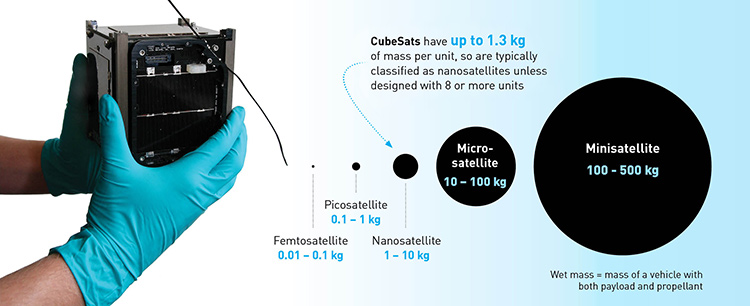 Left: A 1U CubeSat inside the clean room at Cal Poly. Right: Types of small satellites and “wet mass” ranges. [CubeSat image: Cal Poly / Infographic by Alessia Kirkland]
Left: A 1U CubeSat inside the clean room at Cal Poly. Right: Types of small satellites and “wet mass” ranges. [CubeSat image: Cal Poly / Infographic by Alessia Kirkland]
CubeSat history
CubeSats fall into the general class of “small satellites,” which have an individual mass of less than 500 kg. More specifically, most CubeSats are less than 10 kg in mass and are considered nanosatellites or picosatellites. By way of comparison, at its 1990 launch, the Hubble Space Telescope had a mass of 11,110 kg; the latest generation of U.S. environmental satellites, NOAA-20, weighed 2,294 kg when launched in November 2017.
Twenty years ago, two California-based professors dreamed up the concept of easy-to-build, low-cost, standardized platforms for sending students’ experiments into space. First, Robert Twiggs, then of Stanford University, Calif., USA (now at Morehead State University, Ky., USA), wanted his graduate students to build a satellite roughly as capable as the Soviet Union’s pioneering Sputnik 1 from 1967, but his students found themselves struggling to develop a complicated launcher for deploying tiny satellites from a rocket.
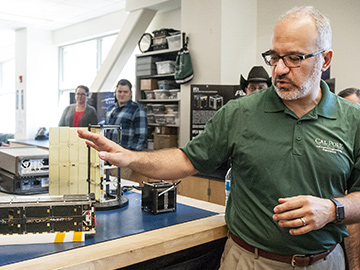 CubeSat pioneer Jordi Puig-Suari, then a professor at California Polytechnic State University and since retired, gives a tour of the PolySat lab to visiting Air Force officials. [Cal Poly]
CubeSat pioneer Jordi Puig-Suari, then a professor at California Polytechnic State University and since retired, gives a tour of the PolySat lab to visiting Air Force officials. [Cal Poly]
Funding from the U.S. Defense Advanced Projects Research Agency (DARPA) enabled the team to create a small, simpler container with a pusher-plate launcher and spring-loaded door. Jordi Puig-Suari, then an aerospace engineering professor at California Polytechnic State University (Cal Poly) at San Luis Obispo, Calif., USA, learned about Twiggs’ work at a 1999 conference and continued the development of the spacecraft framework and launch pod into a consistent standard.
Back then, Puig-Suari, now retired from Cal Poly, had no idea that those first steps would lead to a worldwide movement. “We wanted to teach students, and that’s it,” he says. In retrospect, he adds, the students demonstrated that they could build satellites with commercial, off-the-shelf components that cost much less than uniquely designed parts and circuitry.
Developing the CubeSat standard was tricky at first because stakeholders kept proposing changes, according to Puig-Suari. After two decades, though, the model has settled down and gained wide acceptance from space agencies, educators and industry. The International Organization for Standardization has even adopted it as ISO 17770:2017. Cal Poly remains one of the world’s hubs for CubeSat information and has a student-run laboratory, PolySat, for building and launching the small spacecraft.
“To be honest, the technology that’s in a CubeSat is really no different than the technology in a large satellite,” says Christopher Lowe, a research fellow in the Advanced Space Concepts Laboratory at the University of Strathclyde, Scotland, U.K. “It’s just a standardized shape and standardized protocols.”
Whether a CubeSat’s payload is as sophisticated as a quantum key distribution experiment or as simple as an amateur-radio relay, designing, testing and launching a satellite with just a few liters of volume can represent an engineering—and sometimes a budgetary—challenge for students and seasoned developers alike. Here’s a closer look at just a few of the mighty mites in the optical-project pipeline.
Remote sensing: Miniature eyes on Earth
Because their comparatively low cost enables scientists to send up multiple satellites with identical or similar instruments, CubeSats make useful platforms for remote sensing of the Earth’s surface and atmosphere. Instead of parking themselves in geosynchronous Earth orbit and focusing intently on one region of the planet, the cubes in low Earth orbit pass over different regions at varying yet predictable times.
Two U.S. companies—Spire Global Inc. and Planet Labs Inc.—build and launch their own fleets of CubeSats and sell the resulting data sets to commercial customers. Spire is flying more than 70 Earth-observation cubes, most of which are 3U in size, that perform radio occultation atmospheric measurements for weather tracking and radio-based automatic identification system (AIS) for ship and cargo tracking. Planet has more than 150 orbiting cubes with visible and near-infrared camera resolution of 3 to 5 m, according to company literature.
Not all remote-sensing CubeSats carry cameras. One team at NASA took a greenhouse-gas-measuring instrument that had already been miniaturized for surface portability and adapted it to fit on a 6U CubeSat bus built by Lawrence Livermore National Laboratory, USA. The device, whimsically dubbed Mini-Carb to evoke a low-carbohydrate diet, updates a decades-old technique for measuring radiation emitted from gases. A laser heterodyne radiometer (LHR) passively collects sunlight and extracts the absorption spectra of gases from the radiation, says Emily L. Wilson, a physical chemist specializing in instrument design at NASA Goddard Space Flight Center, USA. A laser serves as the local oscillator in the frequency-conversion process.
Laser heterodyne radiometry was developed in the 1970s, but required large, high-power lasers that limited the portability of the equipment. A few years ago, Wilson miniaturized the LHR with distributed-feedback diode lasers operating at near-infrared wavelengths, which covers several spectral lines of carbon dioxide and methane. The portable instrument, which fits into a backpack-sized plastic instrument case, has traveled to the Netherlands, Scotland and the Amazon River basin.
Mini-Carb was born when Livermore researchers offered Wilson the opportunity to place her LHR aboard a bus that the Livermore team had built to CubeSat specifications. Sometime this year, the U.S. Air Force Space Test Program will launch the satellite from Florida, USA, into a high-inclination orbit that will give the team one-to-four-minute-long observation periods. The Mini-Carb LHR will perform occultation viewing; Wilson says the instrument will observe a 10-to-30-km slice of the atmosphere as sunlight passes obliquely through the atmosphere and toward the satellite.
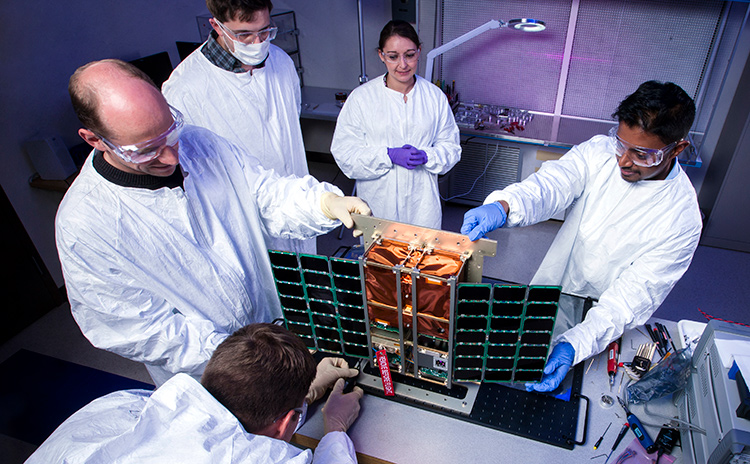 Technologists integrate a Goddard-developed instrument into Lawrence Livermore National Laboratory’s (LLNL) CubeSat bus. [Lawrence Livermore National Laboratory]
Technologists integrate a Goddard-developed instrument into Lawrence Livermore National Laboratory’s (LLNL) CubeSat bus. [Lawrence Livermore National Laboratory]
Commerce and communications
Lowe, whose background is in both industry and academia, sees the delivery of universal broadband internet service as a promising future market for CubeSats. In many developing countries and rural areas, installing the underground optical-fiber network now enjoyed in most cities would be prohibitively expensive. “Bringing in broadband signal anywhere via satellite is more attractive,” he adds, “because everyone needs more bandwidth to get on with modern life.”
Several teams have plans to employ CubeSats in demonstrations of free-space laser communications—and one U.S. organization has already carried out such an experiment, known as the Optical Communications and Sensor Demonstration (OCSD) mission. In late 2017, the Aerospace Corp. launched two 1.5U CubeSats as a secondary payload from a cargo spacecraft that resupplied the ISS.
The OCSD transmitter incorporates a 1064-nm-wavelength diode laser and two ytterbium-doped fiber amplifiers. To simplify the system, the Aerospace researchers hard-mounted the laser to the satellite, so that the entire craft had to rotate in order to point the signal in the direction of the ground station and its 40-cm optical telescope.
Last summer, the team reported that one of the twin satellites used its onboard laser to transmit data at 100 Mbps to the company’s ground station in El Segundo, Calif., USA. The pair of CubeSats also used their onboard global positioning system (GPS) receivers—and a novel water-powered thruster system—to fly in formation only 6 m apart.
The Aerospace Corp. began evaluating various types of miniaturized spacecraft in the early 2000s and adopted the CubeSat standard “when it was clear it was going to be a reliable tool,” says Richard Welle, senior scientist for small satellite concepts. Welle predicts that free-space lasers will become “the hands-down winner” for CubeSat-to-ground communications in the coming years, because of the laser systems’ lower volume and power requirements, higher data rates and a comparative absence of regulatory issues.
Other concepts for CubeSat laser communications are in the works. At the Massachusetts Institute of Technology (MIT), USA, Kerri Cahoy, associate professor of aeronautics and astronautics, has patented a micro-electro-mechanical-systems (MEMS) fast-steering mirror to give a CubeSat precise pointing control. It hasn’t flown yet, but Cahoy and her team have incorporated the MEMS mirror into the Nanosatellite Optical Downlink Experiment (NODE), a 1.2U device with a 1550-nm laser and a mass of 1 kg. The laboratory built an engineering model of NODE and a compatible ground station out of commercial off-the-shelf hardware.
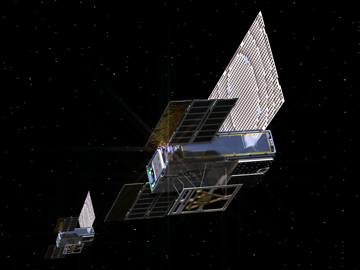 An artist’s rendering of the twin Mars Cube One (MarCO) spacecraft as they fly through deep space. [NASA Jet Propulsion Laboratory]
An artist’s rendering of the twin Mars Cube One (MarCO) spacecraft as they fly through deep space. [NASA Jet Propulsion Laboratory]
Traveling beyond Earth’s orbit
Though most CubeSats putter around in low Earth orbit, a few aim to leave the gravity well of the third planet. Two have already departed—and have achieved conspicuous success. NASA’s InSight robotic Mars lander, which landed on Mars on 26 November 2018 after a six-month, 458 million-km journey, brought twin 6U CubeSats along to serve as radio-communications relays. The Mars Cube One (or MarCO) CubeSats separated from the mother ship early in the journey to test their survivability in deep space.
When InSight landed on the red planet, it was on the far side of Mars from Earth’s perspective. The two MarCO relay satellites thus had a starring role during the InSight landing webcast. They performed flawlessly, picking up the ultra-high-frequency transmissions from the main spacecraft during its approach and landing and passing the data on to Earth at an X-band frequency.
Other CubeSats are slated to leave Earth orbit aboard a huge rocket that has yet to launch. The very first flight of the Space Launch System (SLS), NASA’s super-heavy-lift expendable rocket, will carry 13 cubes into lunar orbit, possibly in 2020. The spring-loaded dispensers for the 13 small satellites will be attached inside the second stage of the SLS and will be deployed after the stage separates from the uncrewed Orion spacecraft, which will measure radiation levels that may affect future astronauts on lunar trips.
NASA selected these CubeSats for the SLS flight, dubbed Exploration Mission 1, based on their onboard experiments’ potential to help fill the agency’s “strategic knowledge gaps” for future solar-system exploration. One of these gaps concerns the possibility that the Moon’s south pole may harbor significant quantities of water ice or other frozen volatiles. Astronomers have circumstantial evidence of water ice in that region; and the Moon Mineralogy Mapper imaging spectrometer aboard India’s Chandrayaan-1 spacecraft found ice in scattered spots, according to Barbara Cohen, a planetary geologist at NASA Goddard. But these hints need to be confirmed and quantified.
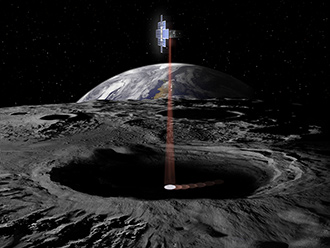 [NASA Jet Propulsion Laboratory]
[NASA Jet Propulsion Laboratory]
Constructing Lunar Flashlight
Lunar Flashlight, one of the secondary payloads on the first flight of NASA’s Space Launch System, will examine the moon’s surface for ice deposits and identify locations where resources may be extracted.
Originally, the 14-kg Lunar Flashlight was supposed to use a solar sail to maneuver through cislunar space, but subsequent calculations showed that the sail could not propel more than 11 kg into lunar-capture orbit, says Barbara Cohen, a planetary geologist at NASA Goddard. Thus, the mission team had to yield 2U—a third of the craft’s volume—to a more conventional propellant-based system. Cohen estimates that the team will be able to collect data for roughly two months with that system.
Since Lunar Flashlight doesn’t require imaging, its engineering team at NASA’s Jet Propulsion Laboratory (JPL) designed the receiver as a 70×70-mm off-axis paraboloidal mirror, which directs incoming light onto a single-pixel indium gallium arsenide detector, according to Quentin P. Vinckier, a JPL postdoctoral fellow who worked on the mission’s instrument design.
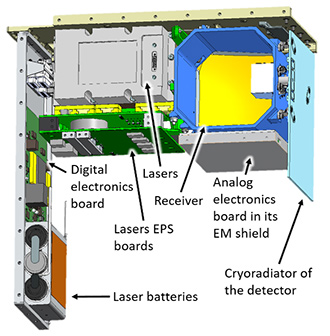 Cutaway drawing of the Lunar Flashlight instrument [NASA Jet Propulsion Laboratory]
Cutaway drawing of the Lunar Flashlight instrument [NASA Jet Propulsion Laboratory]
Enter Lunar Flashlight, one of the 13 CubeSats that will a ride on the SLS. According to Cohen, who leads the mission’s science team, the 6U spacecraft will “flash” 1-ms to 6-ms sequential diode-laser pulses of four distinct wavelengths between 1 μm and 2 μm at the lunar south pole on each orbital pass. Some light gets reflected, some gets absorbed, and the craft’s detector collects the reflected laser light as well as the background between pulses.
Two of the laser wavelengths (1.495 μm and 1.99 μm) match spectral features of water, and two (1.064 μm and 1.850 μm, corresponding to the nearby continuum) do not. The differences in reflected-light ratios will reveal the locations of dry and icy portions of lunar regolith. “If it’s dry,” Cohen says, “then we wouldn’t expect there to be any absorption in those water-ice bands, so they would come back the same as the continuum.”
“We’ve never had an instrument like this on any other spacecraft,” Cohen says. Verifying that this kind of compact laser spectroscopy works in space is one of the mission’s goals. Because the laser reflectometer is so low power and compact, the CubeSat must swoop down to within 20 km of the lunar south pole to have any hope of detecting the bounced pulses. Since it can’t maintain a stable orbit at that low altitude without using vast quantities of propellant, Lunar Flashlight will place itself into a highly elongated orbit, with its apolune (farthest point from the Moon’s surface) at 9000 km. The orbit will take about five days, with just a three-minute window for collecting south-pole data, she says.
“Our biggest challenge is getting something that will make the measurement with the signal-to-noise [ratio] that we need, given the power and limitations of the 6U spacecraft,” Cohen says. NASA is aiming to map the polar water ice, if it exists, with a resolution of 1 to 2 km.
The other 12 CubeSats that will fly on the first SLS mission include a solar-sail-powered explorer of a near-Earth asteroid, two satellites that will study space weather and an additional lunar-ice prospector designed by Morehead State University.
Prospects for the CubeSat paradigm
Nobody expects CubeSats to last as long as the Hubble Space Telescope, which entered Earth orbit in 1990, or the Voyager probes, which are heading into interstellar space more than 40 years after their launch. Two years is considered a good lifespan for the typical CubeSat that isn’t destroyed in a launch accident or doesn’t malfunction when it is first switched on.
One might think that the proliferation of short-lived CubeSats might lead to a vast space-junk problem in low Earth orbit. Lowe, however, believes that most of the cubes will undergo orbital decay from the drag at the top of the atmosphere and will eventually burn up on re-entry.
The generation that has seen computers shrink down to the size of a smartphone now stands poised to send their tiny avatars on grand scientific quests.
Jumping on the CubeSat bandwagon starts with an online search. The CubeSat community maintains a website with links to the latest version of the design specifications for satellites up to 6U in size. NASA provides a comprehensive “CubeSat 101” document that, while centered on the United States, nevertheless outlines the development journey for prospective builders, touching on feasibility reviews, regulatory licensing, documentation development and flight certification.
In the United States, both NASA and the National Science Foundation sponsor programs to encourage CubeSat development. In particular, NASA’s CubeSat Launch Initiative gives teams from NASA centers, educational institutions and nonprofit organizations access to launch services for their qualified projects. Across the Atlantic Ocean, the European Space Agency has a “Fly Your Satellite!” program for university students and recently chose CubeSat companions to ride along on its early-2020s Hera mission to the Didymos asteroid system.
Ever since embarking on the Apollo program 50 years ago, space-exploration advocates have dreamed of making the great beyond more accessible to humans. “Faster, better, cheaper” was NASA’s mantra about 20 years ago, but large, complex spacecraft from the space shuttle to the great observatories still threw up institutional and technological barriers between Earth and the rest of the universe. The generation that has seen computers shrink down to the size of a smartphone now stands poised to send their tiny avatars on grand scientific quests.
Patricia Daukantas is a freelance science writer based in Greenbelt, Md., USA.
References and Resources
-
The website www.CubeSat.org hosts the current design specifications for the small satellites, as well as links to topical conferences and manufacturers of CubeSat hardware.
-
J.A. Champagne et al. “CubeSat image resolution capabilities with deployable optics and current imaging technology,” 28th AIAA/USU Conf. on Small Satellites (2014).
-
T. Imkin. “Payload developments on the Lunar Flashlight mission,” 13th CubeSat Dev. Workshop (California Polytech. State Univ., April 2016).
-
Achieving Science with CubeSats: Thinking Outside the Box (Washington, DC: National Academies Press, 2016).
-
M. Swartout. “The first one hundred CubeSats: A statistical look,” J. Small Satellites 2, 213 (2013).
-
Q. Vinckier et al. “Lunar Flashlight CubeSat mission: A multi-band SWIR laser reflectometer to map and quantify water ice on the lunar South Pole,” 7th Interplanet. CubeSat Workshop (Paris, France, May 2018).
-
R.P. Welle et al. “CubeSat-scale laser communications,” 31st Space Symposium, Technical Track (Colorado Springs, Colo., USA, April 2015).
-
E.L. Wilson et al. “A 4 U laser heterodyne radiometer for methane (CH4) and carbon dioxide (CO2) measurements from an occultation-viewing CubeSat,” Meas. Sci. Technol. 28, 035902 (2017).
